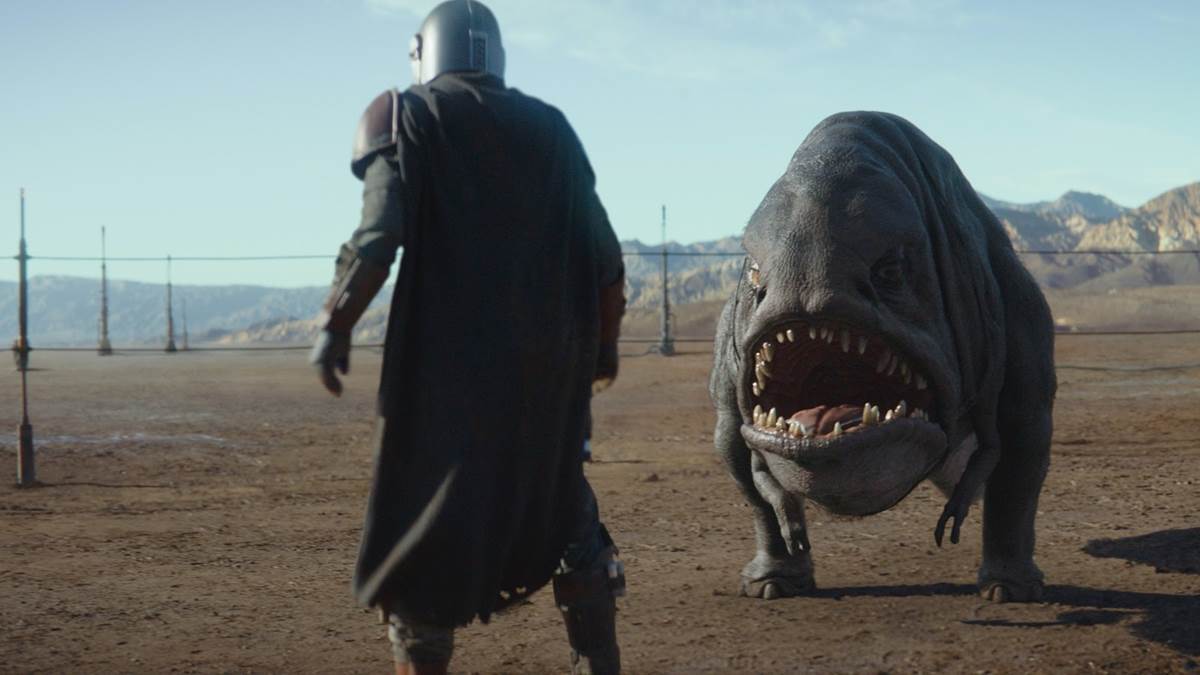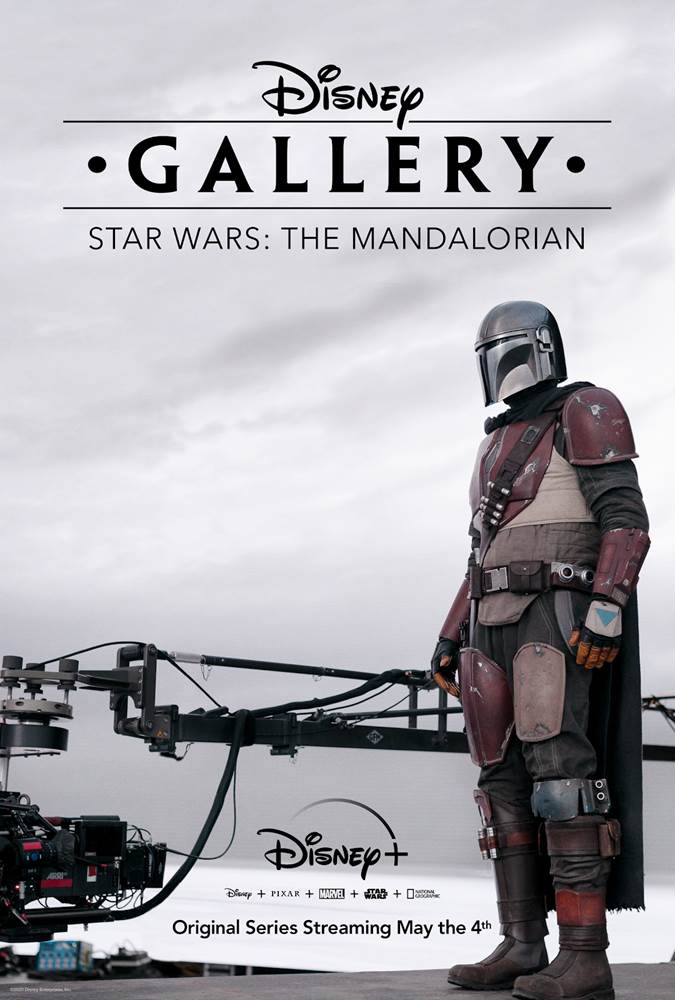Hello and welcome to the eighth and final installment of Laughing Place’s weekly recap of the Disney+ behind-the-scenes docuseries Disney Gallery: The Mandalorian. In this week’s wrap-up episode, entitled “Connections,” The Mandalorian creator/showrunner Jon Favreau and executive producer Dave Filoni run through some of the many Easter Eggs and references to other Star Wars media. Plus, we learn more about the 501st Legion of Stormtroopers’ participation in the series and a secret voice-over cameo by Luke Skywalker actor Mark Hamill.
In the bullet-point list below, I’ve selected the most fascinating factoids and tidbits from this final episode of Disney Gallery: The Mandalorian.
- The Incinerator Stormtrooper from Chapter 8 “Redemption” was taken from the Legends-canon 2008 video game Star Wars: The Force Unleashed.
- The E-Web cannon used by the Imperial remnant in The Mandalorian originated in The Empire Strikes Back.
- Moff Gideon’s Death Troopers originated in Rogue One: A Star Wars Story.
- Some of the costumes used in The Mandalorian were built for other Star Wars projects.
- The “Camtono” used by Werner Herzog’s character to deliver the beskar metal to the Mandalorian was inspired by a famously out-of-place ice cream maker prop carried by a character named Willrow Hood in The Empire Strikes Back. “The Running of the Willrow Hoods” has become a popular cosplay moment among fans at Star Wars Celebration events. Willrow Hood even has a Star Wars action figure.
- Favreau wanted The Mandalorian to feature characters and species that were only in the background in previous Star Wars movies such as Devaronians and Trandoshans.
- The bounty droid IG-11 was obviously inspired by IG-88 from The Empire Strikes Back, and that original character was built out of parts of the Cantina set from the original Star Wars— it did not have feet designed for it in Empire.
- In Chapter 1’s opening scene the Quarren character’s species came from “Squid Head” in Jabba’s Palace from Return of the Jedi. They are the sister species to the Mon Calamari and have also appeared in Star Wars: The Clone Wars. The mechanical Quarren mask they used during production had too much movement in its tentacles, so Favreau and Filoni decided to dial it back.
- The Blurrgs originated in the made-for-television Star Wars spinoff movie Ewoks: The Battle for Endor, but they have also appeared in Filoni’s animated Star Wars TV series.
- Ugnaughts were workers on Cloud City in The Empire Strikes Back. Nick Nolte’s Ugnaught character Kuiil was originally supposed to speak only in grunts and squeaks, but Filoni and Favreau decided he had too much dialogue to have him be subtitled the entire time.
- The first human face that Dave Filoni ever directed in live-action was Werner Herzog’s.
- The IT-O interrogation droid from chapter 3 “The Sin” originated in Star Wars: Episode IV: A New Hope.
- The Imperial Troop Transport vehicle in Chapter 7 “The Reckoning” was first a 1979 Kenner Star Wars toy, but it has also been used in Star Wars Rebels and in many Star Wars comic books.
- Favreau wanted to cast actors who were either fans of Star Wars or who had a body of work outside Star Wars that fans would already be familiar with.
- The GNK-series power droid in the Client’s headquarters was first seen in the Jawa Sandcrawler in the original Star Wars film.
- The TT-8L/Y7 gatekeeper droid used by the Client was first seen at the door to Jabba’s Palace in Return of the Jedi.
- Obviously Jawas, Tusken Raiders, Banthas, the Mos Eisley Cantina, and the Mouse Droid all first appeared in the original Star Wars.
- The AT-ST walker featured in Chapter 4 “Sanctuary” originated in The Empire Strikes Back and Return of the Jedi. As had been observed elsewhere, Jon Favreau confirms this episode of The Mandalorian was inspired by Akira Kurosawa’s Seven Samurai. The animation on the AT-ST was modified to more closely match the stop-motion process used to animate the walker in the Original Trilogy.
- The Amban sniper rifle used by Din Djarin was inspired by Boba Fett’s weapon in the animated segment of The Star Wars Holiday Special. George Lucas continues to disown that special even here.
- The Kubaz ferryman in Chapter 1 was inspired by the character of Garindan (or Long-Snoot) from the original Star Wars.
- The Darksaber originated in Star Wars: The Clone Wars and carried through to Star Wars Rebels. It was previously wielded by a character named Pre Vizla, who was voiced by none other than Jon Favreau.
- The EV-9D9 droid bartender in Chapter 5 “The Gunslinger” was voiced by Mark Hamill in a cameo appearance. Additionally, the astromech droid in the Mos Eisley Cantina is intended to be R5-D4, the droid who had a “bad motivator” in A New Hope, causing Luke to purchase R2-D2 instead.
- The TIE Fighter with collapsible wings was created by concept art by design supervisor Doug Chiang years ago but had never been used before this point.
- The production did not have enough Imperial Stormtrooper costumes for the purposes of the first Moff Gideon sequence, so Dave Filoni invited members of the Southern California and Bay Area chapters of the 501st Legion fan group to appear on the series.
- Though the 501st often makes public appearances at the behest of Lucasfilm, they did not know what they were contributing to when they showed up to The Mandalorian set. They were asked to keep the appearance a secret until the above photo was shown at Star Wars Celebration 2019 in Chicago.
- Visual effects supervisor John Knoll appeared in the Star Wars Special Edition as multiple X-Wing pilots and in Star Wars: Episode I – The Phantom Menace as the only Naboo pilot who gets blown up on-screen.
- Dave Filoni goes into further details about his cameo appearance as a Rebel X-Wing pilot in The Mandalorian. His character’s name is Trapper Wolf and the cockpit they used was on its way to become part of Star Wars: Galaxy’s Edge at Walt Disney World. He says the experience gave him insight into what it must be like to be an actor on a Star Wars project. Jon Favreau made up the dialogue for this scene on the spot.
- Favreau says his favorite part of working on The Mandalorian was coming up with ideas and seeing the art department execute them throughout the development and pre-production processes.
All eight episodes of Disney Gallery: The Mandalorian are now available to stream exclusively on Disney+.







